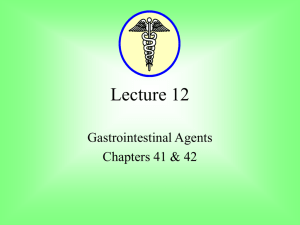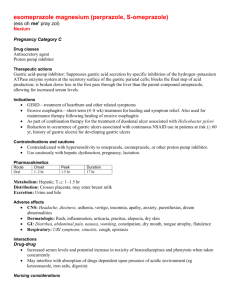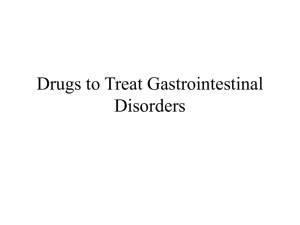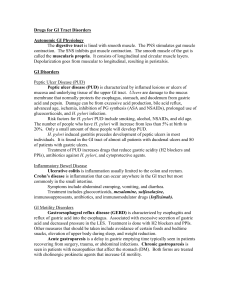Lecture 12 - Harper College
advertisement
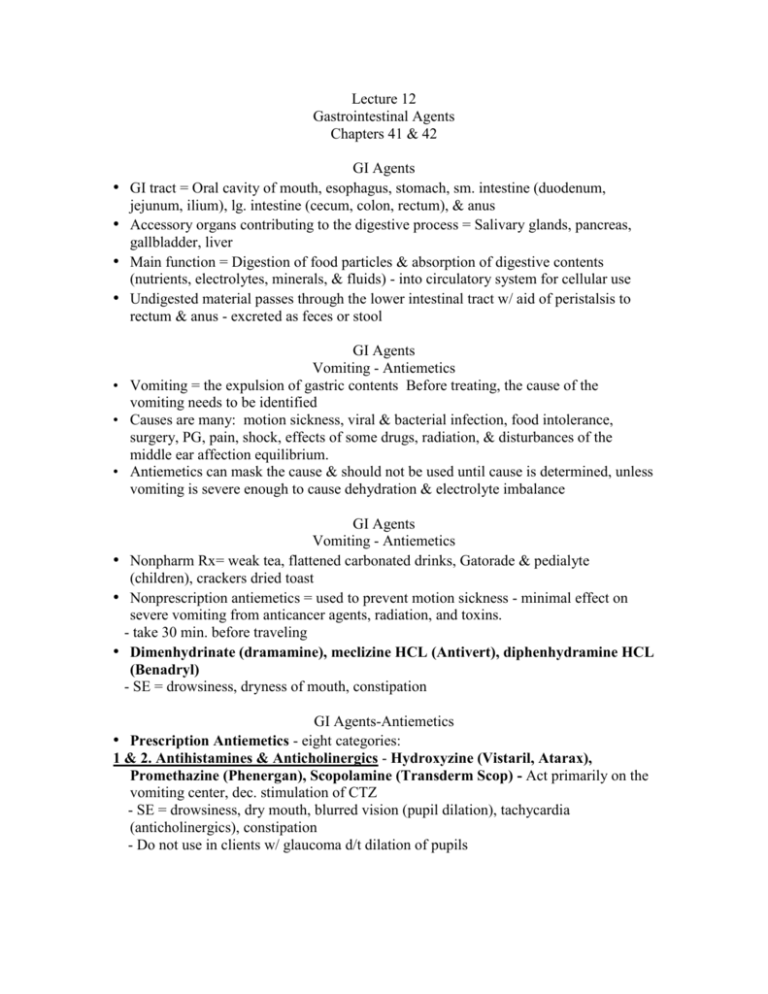
Lecture 12 Gastrointestinal Agents Chapters 41 & 42 • • • • GI Agents GI tract = Oral cavity of mouth, esophagus, stomach, sm. intestine (duodenum, jejunum, ilium), lg. intestine (cecum, colon, rectum), & anus Accessory organs contributing to the digestive process = Salivary glands, pancreas, gallbladder, liver Main function = Digestion of food particles & absorption of digestive contents (nutrients, electrolytes, minerals, & fluids) - into circulatory system for cellular use Undigested material passes through the lower intestinal tract w/ aid of peristalsis to rectum & anus - excreted as feces or stool GI Agents Vomiting - Antiemetics • Vomiting = the expulsion of gastric contents Before treating, the cause of the vomiting needs to be identified • Causes are many: motion sickness, viral & bacterial infection, food intolerance, surgery, PG, pain, shock, effects of some drugs, radiation, & disturbances of the middle ear affection equilibrium. • Antiemetics can mask the cause & should not be used until cause is determined, unless vomiting is severe enough to cause dehydration & electrolyte imbalance GI Agents Vomiting - Antiemetics • Nonpharm Rx= weak tea, flattened carbonated drinks, Gatorade & pedialyte (children), crackers dried toast • Nonprescription antiemetics = used to prevent motion sickness - minimal effect on severe vomiting from anticancer agents, radiation, and toxins. - take 30 min. before traveling • Dimenhydrinate (dramamine), meclizine HCL (Antivert), diphenhydramine HCL (Benadryl) - SE = drowsiness, dryness of mouth, constipation GI Agents-Antiemetics • Prescription Antiemetics - eight categories: 1 & 2. Antihistamines & Anticholinergics - Hydroxyzine (Vistaril, Atarax), Promethazine (Phenergan), Scopolamine (Transderm Scop) - Act primarily on the vomiting center, dec. stimulation of CTZ - SE = drowsiness, dry mouth, blurred vision (pupil dilation), tachycardia (anticholinergics), constipation - Do not use in clients w/ glaucoma d/t dilation of pupils GI Agents - Antiemetics • Phenothiazine - largest group of drugs used for N & V Chlorpromazine (Thorazine), prochlorperazine edisylate (Compazine) - most frequently prescribed, perphenazine (Trilafon) - frequently used w/ anticancer therapy - Action - inhibits dopamine in the CTZ thus dec. CTZ stimulation of the vomiting center - Use - severe N & V from sugery, anesthetics, chemo & radiation sickness - SE = dry mouth, drowsiness, EPS, dizziness, hypotension GI Agents Antiemetics • Butyrophenones - Haloperidol (Haldol), droperidol (Inapsine) - block dopamine-2 receptors in the CTZ - Use - Rx of post-op N & V & emesis associated w/ toxins, chemo & radiation therapy - SE - EPS if used over extended time, hypotension • Metoclopramide - metoclopramide (Reglan) - blocks dopamine & serotonin receptors in the CTZ - Use = post-op emesis, chemo & radiation therapy - SE = sedation & diarrhea w/ high doses GI Agents Antiemetics 4. Benzodiazepines - Lorazepam (Ativan) - for N & V d/t chemo - May be given w/ an antiemetic such as metoclopramide (Reglan) 5. Serotonin Antagonists - ondansetron (Zofran), granisetron (Kytril) - Action - suppress N & V by blocking the serotonin receptors in the CTZ & afferent vagal nerve terminals in upper GI tract - Do not cause EPS symptoms - Use - chemo induce emesis - PO & IV - SE - headache, diarrhea, dizziness, fatigue GI Agents - Antiemetics 6. Glucocorticoids - Dexamethasone (Decadron), methylprednisolone (Solu-Medrol) - effective w/ chemo treatment in suppressing emesis - given IV 7. Cannabinoids - active ingredient in marijuana - approved for clinical use since 1985 to alleviate N & V from cancer treatments - dronabinol (Marinol), nabilone (Cesamet) - for clients unable to use or respond to other antiemetics - SE = mood changes, euphoria, drowsiness, nightmares, dry mouth, confusion, HA, depersonalization, nightmares, incoordination, memory lapse, orthostasis, hypertension & tachycardia GI Agents Antiemetics/Emetics 8. Miscellaneous - Benzquinamide HCL (Emete-Con), diphenidol (Vontrol), trimethobenzamide (Tigan) - suppress the impulses to the CTZ, Vontrol also prevents vertigo by inhibiting impulses to the vestibular area - labeled misc. because they don’t act strictly as antihistamines, anticholinergics, or phenothiazides - SE = drowsiness, anticholinergic symptoms, CNS stimulation, EPS GI Agents - Emetics GI • Diarrhea = frequent liquid stool d/t an intestinal disorder - causes: foods, fecal impaction, bacteria, virus, drug rxn, laxative abuse, malabsorption syndrome, stress, bowel tumor, inflammatory bowel disease - can be mild to severe - ID underlying causes first - can cause minor or severe dehydration & electrolyte imbalance - can be life threatening to the young & elderly • Nonpharm Rx = clear liquids & oral soln’s (gatorade, pedialyte), IV electrolyte soln’s….. (BRAT diet) • • • • GI Agents - Antidiarrheals Used to decrease hypermotility (inc. peristalsis cause of diarrhea - needs to be corrected) Do not use longer that 2 days & not use with fever. Underlying cause must be found. (Ex. E. Coli) 4 categories (Opiates, opiate related agents, adsorbents antidiarrheal combos) Opiates - decrease intestinal motility thus dec. peristalsis tincture of opium, paregoric, codeine - in combo w/ other agents SE = CNS depression ( taken with ETOH, sedatives or tranqs), constipation Duration = 2 hrs. Opiate-Related Agents - Diphenoxylate (Lomotil), loperamide (Imodium) synthetic drugs chemically related to meperidine - Action - decrease intestinal motility - “travelers diarrhea” - SE = N & V, drowsiness, abd. Distention GI Agents - Antidiarrheals GI Agents Constipation • Constipation - accumulation of hard fecal material in the large intestine - a major problem of the elderly - Causes - poor H2O intake & poor dietary habits, ignoring the urge, fecal impaction, bowel obstruction, chronic laxative use, neurologic disorders (paraplegia), lack of exercise, selected drugs (anticholinergics, narcotics & certain antacids) • Nonpharm Rx = diet that contains fiber, water, exercise, routine bowel habits (normal can be 1-3/day or 3/wk – varies from person to person) The freq. is secondary to consistency – feces hard & dry GI Agents - Constipation GI Agents -Laxatives • Osmotic Laxatives (Hyperosmolar laxatives) - include salts or saline products, lactulose, & glycerine Lactulose (Cephulac), Magnesium hydroxide (MOM), sodium biphosphate (Fleet Phospho-Soda), Fleet enema • Action – These poorly absorbed salts osmotic action draws water into the intestine, inc. H20 causes fecal mass to soften and swell stretches intestine & stimulate peristalses. • Saline preps contains NA+, Mg+, a small amt. may be systemically absorbed so CI in poor renal function • • • • • GI Agents - Laxatives Osmotic laxatives contain 3 electrolytes (NA+, MG+, K+) Used in bowel prep for dx & surg. procedures Polyethylene glycol (PEG) or (GoLytely) – non absorbable osmotic substance, so can be used by clients with renal impair or cardiac probs, PO 3 to 4 liters over 3 hours for bowel prep. Lactulose (saline lax) draws H2O into the intestines - SE = flatulence, diarrhea, abd. cramping, N & V CI: Clients w/ CHF, w/ renal insufficiency should avoid magnesium salts, in some laxatives (Milk of Mag) Electrolytes should be monitored. GI Agents Laxatives • Stimulant (Contact) Laxatives - Increase peristalsis by irritating sensory nerve endings in the intestinal mucosa phenolphytalein (Ex-Lax), biscadyl (Dulcolax), senna (Senokot), castor oil (purgative) - Biscadyl & phenolpythalein are two of the most frequently used & abused laxatives OTC - Castor Oil = harsh laxative that acts on the small bowel & produces a watery stool - SE = Nausea, abd. cramps, weakness, Fluid & electrolyte imbalances w/ chronic use GI Agents - Laxatives • Bulk-Forming Laxatives - Calcium polycarbophil (FiberCon), methylcellulose (Citrucel), psyllium hydrophilic mucilloid (Metamucil) - Natural fibrous substances that promote lg. soft stools by absorbing water into the intestine - inc. fecal bulk & peristalsis - Does not cause laxative dependence & may be used by clients w/ diverticulosis, irritable bowel syndrome & ileostomy & colostomy - Powders mixed w/ H2O or juice, drink immediately, followed by a full glass GI Agents - Laxatives • Emollients (Surfactants) - Docusate calcium (Surfak), docusate potassium (Dialose), docusate sodium (Colace), docusate sodium w/ casanthranol (PeriColace) - Stool softeners (surface acting drugs) and lubricants used to prevent constipation - dec. straining during defecation - Action - lowers surface tension & promotes H2O accumulation in the intestine and stool - Use - after an MI, post-op - SE - N & V, diarrhea, cramping • • • • GI Agents Antiulcer Drugs Peptic Ulcer - a broad term for an ulcer occurring in the esophagus, stomach, or duodenum w/in the upper GI tract (esophageal, gastric & duodenal ulcers). Ulcers develop when there is an imbalance between mucosal defensive factors & aggressive factors. Maj. defensive factors are mucus & bicarb. (Keep stomach & duodenun from self–digestion) Major aggressive - H. pylori, NSAID, gastric acid, & pepsin Duodenal ulcers 10X more frequent than gastric, esophageal Release of hydrochloric acid (HCL) from the parietal cells of the stomach influenced by histamine, gastrin & acetylcholine - Peptic ulcers caused by hypersecretion of HCL & pepsin, erode the GI mucosal lining GI Agents Antiulcer Drugs • Gastric secretions of the stomach strive to keep a pH of 2 to 5 Pepsin-a digestive enzyme is activated at a pH of 2, the acid-pepsin complex of gastric secretions can cause mucosal damage - If the pH inc. to 5 - the activity of pepsin declines • Gastric Mucusal Barrier (GMB) - thick, viscous, mucous material that provides a barrier between the mucosal lining & the acidic gastric secretions - defense against corrosive substances, maintains integrity of the gastric mucosal lining GI Agents - Antiulcer Drugs • Two sphincter muscles: - Cardiac - located at the upper portion of the stomach - prevents reflux of acid into the esophagus - pyloric - located at the lower portion of the stomach - prevents reflux of acid into the duodenum * Esophageal ulcers reflux of acidic gastric secretion into the esophagus d/t a defective or incompetent cardiac sphincter * Duodenal ulcers hypersecretion of acid from the stomach that passes to the duodenum * Gastric ulcer breakdown of GMB (gastric mucosal barrier) GI Agents - Antiulcer Drugs • Predisposing factors - mechanical disturbances, genetic, bacterial organisms, environmental, drugs - Nurse needs to help identify & teach ways to avoid • Symptoms = gnawing, aching pain - gastric = 30 min. – 1 1/2 h after eating - duodenal - 2 - 3 h after eating • Stress ulcer usually follows a critical situation - trauma, major surgery - prophylactic use of antiulcer drugs dec. the incidence of stress ulcers GI Agents - Antiulcer Drugs • Helicobacter pylori (H. pylori) - a gram (-) bacillus linked w/ the development of peptic ulcer - H. pylori known to cause gastritis, gastric ulcer & duodenal ulcer –When a peptic ulcer recurs after anti-ulcer tx and it’s not caused by NSAIDS such as ASA or Ibuprofen client should be tested for H. pylori GI Agents – Antiulcer GI Agents - Antiulcer Drugs • Gastroesophageal reflux Disease (GERD) - 40 to 45% of adults have heartburn in many cases d/t GERD - Inflammation of the esophageal mucosa caused by reflux of gastric acid content into the lower esophageal sphincter - Rx similar to treatment of peptic ulcers - the use of common antiulcer drugs to neutralize gastric contents & reduce acid secretion - A chronic disorder requiring continuous management & education GI Agents Antiulcer Drugs • Nonpharm Rx = avoiding smoking & ETOH can dec. gastric secretions, wt. loss (obesity enhances GERD), avoid hot, spicy, greasy foods, Take NSAIDs w/food, do not eat before bedtime • Pharmacologic Rx = there are 8 groups of antiulcer agents 1. Tranquilizers - minimal effect in preventing & treating ulcers. Reduce vagal stimulation & dec. anxiety Librax - combo of anxiolytic chlordiazepoxide (Librium) & the anticholinergic clidinium (Quarzan) used in the treatment of ulcers GI Agents Antiulcer Drugs 2. Anticholinergics - Not used as much w/ the newer drugs on board. Relieve pain by dec. GI motility & secretion 3. Antacids - Promote ulcer healing by neutralizing HCL & reducing pepsin activity; they do not coat the ulcer, Two types: Systemic or non systemic Calcium carbonate (Tums)- Systemically absorbed antacid - neutralizes acid, however, 1/3 to 1/2 of drug systemically absorbed & causes acid rebound. Hypercalcemia can result from excess use Sodium bicarb.- systemically absorbed many SE = hypernatremia, water retention are a few GI Agents Antiulcer Drugs • Nonsystemic antacids composed of alkaline salts - aluminum (aluminum hydroxide Amphojel) and magnesium (magnesium hydroxide - Maalox, Mylanta) - The combo of magnesium & aluminum neutralizes gastric acid w/o causing constipation or severe diarrhea - aluminum itself causes constipation & magnesium alone can cause diarrhea - Ideal dosing is 1 and 3 h after meals GI Agents Antiulcer Drugs 4. Histamine -2 Blockers (H2) or histamine-2 receptor antagonists - most popular drugs used to treat ulcers - Action - Block the H2 receptors of the parietal cells in the stomach, thus reducing gastric acid secretion & concentration to promote healing Cimetidine (Tagamet), Famotidine (Pepcid), Nizatidine (Axid), ranitidine (Zantac) - Tagamet = first H2 blocker - Need good kidney function, 50-80% of drug excreted unchanged in the urine do not give w/ antacids - dec. effectiveness of drug GI Agents - Antiulcer Drugs - Zantac, Pepid, & Axid = more potent – in addition to blocking of gastric secretion they also promote healing of the ulcer by eliminating its cause. - Duration of action longer & fewer side effects - Use - to treat gastric & duodenal ulcers & can be used prophylactically also useful in relieving symptoms of reflux esophagitis, preventing stress ulcers postop - SE = headaches, dizziness, constipation, rash - DI = many w/ cimetidine - check carefully GI Agents Antiulcer Drugs 5. Proton Pump Inhibitors (gastric acid secretion inhibitors, gastric acid pump inhibitors (PPIs) - suppress gastric acid secretion by inhibiting the hydrogen / potassium ATP-ase enzyme system located in the gastric parietal cells, they tend to inhibit gastric acid secretion up to 90% greater than the H2 blockers - these agents block the final step of acid production Omeprazole (Prilosec), lansoprazole (Prevacid) - Used for Rx of peptic ulcers & GERD - highly protein-bound SE = headache, dizziness, diarrhea, abd. pain, rash * Monitor liver enzymes GI Agents Antiulcer Drugs 6. Pepsin Inhibitor - Sucralfate (Carafate) - a mucosal protective drug. Nonabsorbable & combines w/ protein to form a viscous substance that covers the ulcer and protects it from acid & pepsin - does not neutralize acid or dec. acid secretions - SE - few because not systemically absorbed, but may cause nausea & constipation 7. Prostaglandin analogue antiulcer drug - Misoprostol (Cytotec) - New for prevention & Rx of peptic ulcers GI Agents - Antiulcer Drugs - Action - It appears to suppress gastric acid secretion & inc. cytoprotective mucus in the GI tract. Causes a mod. dec. in pepsin secretion - Use - gastric distress from taking NSAIDs, ASA & indomethacin that are prescribed for long-term therapy - CI - during pregnancy & for women of child bearing yrs. 8. GI stimulants - Cisapride (Propulsid) - increases gastric emptying time preventing acid reflux - used for nocturnal heartburn & GERD CI - cardiac dysrhythmias, heat disease, CHF - an ECG should be done before & during therapy, renal & resp. failure

